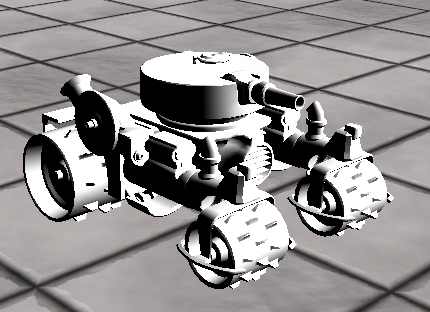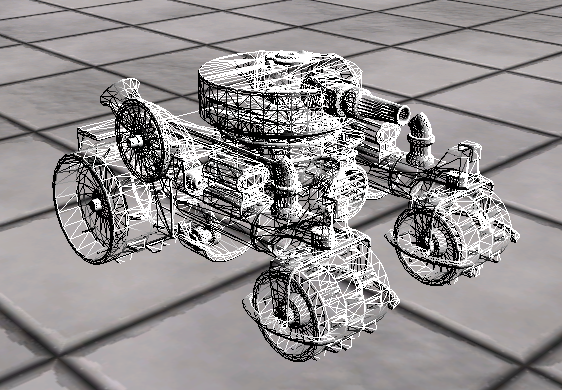Model
이 전에 모델 데이터를 Mesh데이터로 변환하는것 까지 했다. 그러면 이것들을 활용해서 모델을 렌더링 해보자!!!!!(아 개힘들다 넘모 많다 ㅠㅠ)
ModelRedner.h
#pragma once
class ModelRender
{
public:
ModelRender(Shader* shader);
~ModelRender();
void Update();
void Render();
public:
void ReadMesh(wstring file);
Transform* GetTransform() { return transform; }
Model* GetModel() { return model; }
void Pass(UINT pass);
void UpdateTransform(ModelBone* bone = NULL, Matrix& matrix = Matrix());
private:
void UpdateBones(ModelBone* bone, Matrix& matrix);
private:
bool bRead = false;
Shader* shader = NULL;
Model* model = NULL;
Transform* transform = NULL;
Matrix transforms[MAX_MODLE_TRANSFORMS];
};
지금까지 만든 Model을 들고있는 클래스이다. 그리고 각각 Mesh마다 Transform을 갖고있는 행렬도 갖고있는다.
ModelRender.cpp
#include "Framework.h"
#include "ModelRender.h"
ModelRender::ModelRender(Shader * shader)
: shader(shader)
{
model = new Model();
transform = new Transform(shader);
}
ModelRender::~ModelRender()
{
SafeDelete(model);
SafeDelete(transform);
}
void ModelRender::Update()
{
if (bRead == true)
{
bRead = false;
for (ModelMesh* mesh : model->Meshes())
{
mesh->SetShader(shader);
}
UpdateTransform();
}
for (ModelMesh* mesh : model->Meshes())
{
mesh->Update();
}
}
void ModelRender::Render()
{
for (ModelMesh* mesh : model->Meshes())
{
mesh->SetTransform(transform);
mesh->Render();
}
}
void ModelRender::ReadMesh(wstring file)
{
model->ReadMesh(file);
bRead = true;
}
void ModelRender::Pass(UINT pass)
{
for (ModelMesh* mesh : model->Meshes())
{
mesh->Pass(pass);
}
}
void ModelRender::UpdateTransform(ModelBone * bone, Matrix & matrix)
{
if (bone != NULL)
{
UpdateBones(bone, matrix);
}
for (UINT i = 0; i < model->BoneCount(); i++)
{
ModelBone* bone = model->BoneByIndex(i);
transforms[i] = bone->Transform();
}
for (ModelMesh* mesh : model->Meshes())
{
mesh->Transforms(transforms);
}
}
void ModelRender::UpdateBones(ModelBone * bone, Matrix & matrix)
{
}
UpdateBones 이 함수는 나중에
이번에는 많진 않다. 이 전에 이미 다 만들어 놓았던걸 갖고온다.
38_Model.fx
#include "00_Global.fx"
float3 Direction = float3(-1, -1, +1);
struct VertexModel
{
float4 Position : Position;
float2 Uv : Uv;
float3 Normal : Normal;
float3 Tangent : Tangent;
float4 BlendIndices : BlendIndices;
float4 BlendWeights : BlendWeights;
};
#define MAX_MODEL_TRANSFORMS 250
cbuffer CB_Bone
{
matrix BoneTransforms[MAX_MODEL_TRANSFORMS];
uint BoneIndex;
};
struct VertexOutput
{
float4 Position : SV_Position;
float3 Normal : Normal;
float2 Uv : Uv;
};
VertexOutput VS(VertexModel input)
{
VertexOutput output;
World = mul(BoneTransforms[BoneIndex], World);
output.Position = WorldPosition(input.Position);
output.Position = ViewProjection(output.Position);
output.Normal = WorldNormal(input.Normal);
output.Uv = input.Uv;
return output;
}
float4 PS(VertexOutput input) : SV_Target
{
float NdotL = dot(normalize(input.Normal), -Direction);
// DiffuseMap.Sample(LinearSampler, input.Uv)
return float4(1, 1, 1, 1) * NdotL;
}
technique11 T0
{
P_VP(P0, VS, PS)
P_RS_VP(P1, FillMode_WireFrame, VS,PS)
}
쉐이더다. 애니메이션을 갖고올수 있는 변수들도 미리 받아높고 VertexOutput에 현재 자식의 본들의 위치까지 한번에 업데이트 해준다.
이러고 렌더링을 하면
잘 나온다.

